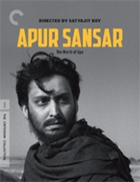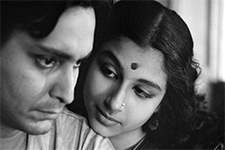| Director: Satyajit Ray | | Screenplay: Satyajit Ray (based on the novel Aparajito by Bibhutibhushan Bandyopadhyay) | | Stars: Soumitra Chatterjee (Apu), Sharmila Tagore (Aparna, Apu’s wife), Swapan Mukherjee (Pulu), Alok Chakravarty (Kajal), Sefalika Devi (Pulu’s wife), Dhiresh Majumdar (Sasinarayan), Dhiren Ghosh (The Landlord) | | MPAA Rating: NR | | Year of Release: 1959 | | Country: India |  |
|  Apur Sansar (The World of Apu), the third and final film in Satyajit Ray’s celebrated “Apu Trilogy,” was never supposed to be made. The idea of making a third film didn’t even occur to Ray until he was asked about it at a press conference at the Venice Film Festival, where the second film in the trilogy, Aparajito (1956), had just won the coveted Golden Lion award, the festival’s highest honor. For reasons that he never could fully clarify, Ray answered that he would make a third film, although it would be several years before he returned to the character of Apu, who was first introduced as a child in his groundbreaking maiden film Pather Panchali (1955). Now played by Soumitra Chatterjee, who would go on to be one of Ray’s most frequent collaborators, starring in 14 of his films, Apu is a young man in his 20s living a life of personal freedom in Calcutta. He is effectively alone in the world, having lost his older sister when he was a child, followed by his father and then his mother when he was a teenager, although he seems at peace with this isolation and lack of familial connection as it allows him to pursue his interests in art and literature unfettered by responsibility to others. Having graduated from school, but unable to afford the cost of continuing his studies at a university, Apu is working hard on a novel and struggling to make ends meet (the landlord arrives at one point, informing him that he is months behind on his rent). Despite the economic hardship, his meager, simple life seems largely fulfilling. Everything changes when he accepts an invitation from his friend, Pulu (Swapan Mukherjee), to attend his cousin’s wedding. The day of the wedding, the groom arrives in a state of mental dishevelment and the bride’s mother cancels the wedding. This puts the teenage bride, Aparna (Sharmila Tagore), in a terrible situation because Hindu custom dictates that, if she is not married during the predetermined “auspicious hour,” she will be ineligible for marriage for the rest of her life. Her distraught father, Pulu, and several villagers appeal to Apu to fill the groom’s shoes in the arranged marriage, a proposition at which he initially balks because it would impinge on his personal freedom (he also decries it as medieval, which suggests how thoroughly modern he has become as a young man). Yet, he eventually relents and marries Aparna, who turns out to be a thoughtful, dedicated young woman who greatly improves Apu’s life with her loving companionship. Not realizing what he had been missing, Apu basks in both her love and her commitment to making their paltry room in Calcutta into a home. But, just as in the previous films, tragedy strikes and rips Aparna from Apu’s life just as she gives birth to their son, which sends Apu into a years-long self-imposed exile of wandering and dislocation. So shocked and grief-stricken by the tragic turn of events, Apu is incapable of reconnecting with anyone, including his own son, to whom he occasionally sends money, but with whom he cannot forge any kind of relationship. Apu’s isolation becomes the worst manifestation of his sensitivity; it is as if his soul can no longer bear the weight of tragic loss after tragic loss, and he simply removes himself from the world he knows, becoming a vagabond who avoids additional pain by disconnecting from everyone. The emotional crux of the film, then, becomes the opposite of Aparajito, which tracked Apu’s general move away from his mother and his family roots toward his own self-actualization. Now, we wait anxiously for him to draw out of his emotional shell and reconnect with the idea of family, specifically through taking the responsibility of being a father to his son, Kajal (Alok Chakravarty), who is, not surprisingly, a physical and spiritual likeness of Apu when he was a mischievous child. As the concluding film of a much beloved trilogy, Apur Sansar is a fitting capstone to one of world cinema’s greatest coming-of-age stories. There is a consistency across the three films that belies the fact that the latter two weren’t originally planned. Part of the films’ visual and emotional consistency derives from the fact that many of the same collaborators worked on all three films, including cinematographer Subrata Mitra, editor Dulal Dutta, and composer Ravi Shankar. While most of the film’s plotting came from the latter two-thirds of Bibhutibhushan Bandyopadhyay’s novel Aparajito, the first third of which had provided part of the story for the trilogy’s middle film, Ray took significant liberties in recreating Apu as a sensitive artist, a man much like his father, but with much greater potential for success in the world. The film’s power derives from the collision between Apu’s dreams and the reality of the world around him, which both thwarts his desires and also recalibrates them (it is, in this regard, a thematic cousin to Frank Capra’s It’s a Wonderful Life). In the best sense, Apu learns about himself—his strengths, but also his limitations. And unlike the previous two films, which ended on images of characters striking out into unknown futures, the final shot of Apur Sansar feels designed to reassure us that all of Apu’s pain and suffering has not been in vain, but has rather been in the service of forging a man who is ready to tackle the future and not recreate the mistakes of his own past. | Apur Sansar Criterion Collection 4K UHD |  Apur Sansar is available as part of The Criterion Collection’s “The Apu Trilogy” 4K UHD boxset, which also includes Pather Panchali (1955) and Aparajito (1956). Apur Sansar is available as part of The Criterion Collection’s “The Apu Trilogy” 4K UHD boxset, which also includes Pather Panchali (1955) and Aparajito (1956). | | Aspect Ratio | 1.37:1 | | Audio | Bengali Linear PCM 1.0 monaural | | Subtitles | English | | Supplements | Audio recordings from 1958 of director Satyajit Ray reading his essay “A Long Time on the Little Road” and in conversation with film historian Gideon BachmannVideo interviews with actor Soumitra ChatterjeeVideo interview with actor Shampa SrivastavaVideo interview with actor Sharmila TagoreVideo interview with camera assistant Soumendu RoyVideo interview with film writer Ujjal Chakraborty“Making The Apu Trilogy: Satyajit Ray’s Epic Debut,” video essay by Ray biographer Andrew Robinson “The Apu Trilogy: A Closer Look,” program featuring filmmaker, producer, and teacher Mamoun HassanExcerpts from the 2003 documentary The Song of the Little Road, featuring composer Ravi ShankarThe Creative Person: “Satyajit Ray” a 1967 half-hour documentaryFootage of Ray receiving an honorary Oscar in 1992Programs on the restorations by filmmaker :: kogonadaInsert booklet featuring essays by critics Terrence Rafferty and Girish Shambu, as well as a selection of Ray’s storyboards for Pather Panchali | | Distributor | The Criterion Collection | | Release Date | January 2, 2024 | | | COMMENTS | | In her 1967 essay “Movies on Television,” which happened to be her debut essay in The New Yorker, Pauline Kael lamented how the availability of movies on television, with its low resolution and tiny screens, was diminishing the movie past. She noted how, on television, certain movies lose “much of what made them worth looking at,” a specific example of which was “the lyricism of Satyajit Ray.” Well, if Kael had lived long enough to see Criterion’s 4K digital restorations of “The Apu Trilogy,” which was undertaken in collaboration with the Academy Film Archive at the Academy of Motion Picture Arts and Sciences and L’Immagine Ritrovata in Bologna, Italy, she might retract her statement since every nuance of Ray’s lyricism in these beautiful films is fully preserved in these beautiful transfers. Criterion The restoration of the three Apu films was a massive endeavor years in the making. Back in 1993, the original camera negatives for all three films were sent to an archive in London where restoration was to begin. Unfortunately, a fire broke out in the archive and all three films suffered serious fire damage, with Apur Sansar being completely destroyed. When Criterion initiated the restoration of the films, they started with the burned remnants of the negatives, which the restoration experts at L’Immagine Ritrovata were able to salvage by rehydrating the celluloid and physically repairing by elements that could be salvaged by hand. In the end, after hundreds of hours of manual labor, 40% of Pather Panchali’s negative and 60% of Aparajito’s negative could be used for wet-gate scanning. The damaged portions were replaced after an exhaustive search of the world’s archives turned up high-quality fine-grain masters and duplicate negatives. In the case of Apur Sansar, the entire film was scanned from a fine-grain master and a duplicate negative. Criterion originally released all three films on Blu-ray back in 2015, and now we have them in their full 2160p glory on 4K UHD. The images on these new discs derive from the same 4K scans from the restored elements, which were then given additional digital restoration over an 8-month period to remove dirt, damage, and audio artifacts. Given that these films were almost lost completely, it is pretty much miraculous how good they look, with a consistency of presentation that erases any evidence of how pieced-together they really are. Granted, they don’t look perfect, and to expect perfection is simply obtuse. Most signs of age and wear have been removed, although there are still the occasional hairlines and a few shots with significant scratching. The images are beautifully rendered in terms of contrast and grayscale, with outstanding detail that will amaze those who have become accustomed to seeing the films in low-resolution transfers from old, worn elements (comparisons to the previously available DVDs doesn’t even seem fair, and the jump from 2K to 4K is noticeable). The sound has been cleaned up substantially, even though there is a slight auditory hiss, especially in Pather Panchali, though it is hardly distracting. Each film in the trilogy improves in terms of technical quality, as Ray worked with increasingly bigger budgets and from a position of greater experience, but they all look fantastic, especially when you know all that they have been through. All of the supplements from the 2015 Blu-ray set are included here, which amounts to several hours of material that contextualize the films historically, culturally, and aesthetically. Ray, who passed away in 1992, is present in several supplements. There is an audio recording from 1958 of him reading his essay “A Long Time on the Little Road,” which documents the production of Pather Panchali, and a recording of him in conversation with film historian Gideon Bachmann. Ray also appears in a 1967 episode of the PBS half-hour documentary series The Creative Person by documentarian James Beveridge, who traveled to Calcutta to interview Ray, several of his actors, members of his creative team, and film critic Chidananda Das Gupta. We also get footage of him receiving the honorary Lifetime Achievement Oscar in 1992, just a few weeks before he died (he wasn’t able to attend the ceremony, so he appeared via video from his hospital bed). There are also several new video interviews with his collaborators, including actors Soumitra Chatterjee, Shampa Srivastava, and Sharmila Tagore and camera assistant Soumendu Roy, as well as excerpts from the 2003 documentary The Song of the Little Road that feature composer Ravi Shankar, who scored all three films. For a critical and historical look at the films, we have a new interview with film writer Ujjal Chakraborty; “Making The Apu Trilogy: Satyajit Ray’s Epic Debut,” a new video essay by Ray biographer Andrew Robinson; and “The Apu Trilogy: A Closer Look,” a new program featuring filmmaker, producer, and teacher Mamoun Hassan. Finally, there is a new program on the restoration of the three films by filmmaker :: kogonada (included is both a short version, used to promote the trilogy’s theatrical release in 2015, and a longer version exclusive to the Criterion box-set), and a thick insert booklet featuring essays by critics Terrence Rafferty and Girish Shambu, as well as a selection of Ray’s storyboards for Pather Panchali. |
Copyright © 2024 James Kendrick Thoughts? E-mail James Kendrick All images copyright © The Criterion Collection |




 (4)
(4)

 Apur Sansar is available as part of The Criterion Collection’s “The Apu Trilogy” 4K UHD boxset, which also includes Pather Panchali (1955) and Aparajito (1956).
Apur Sansar is available as part of The Criterion Collection’s “The Apu Trilogy” 4K UHD boxset, which also includes Pather Panchali (1955) and Aparajito (1956).